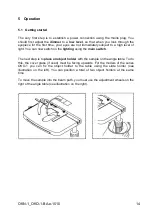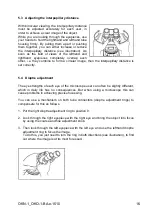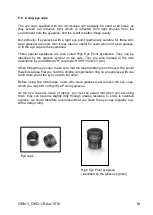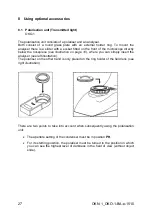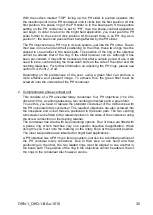
OKN-1_OKO-1-BA-e-1510
28
8.2 Camera connection (only for trinocular version)
Due to the trinocular tube, which can be optionally fitted for the OKN-1 and OKO-1
series, it is possible to connect microscope cameras to the device, in order to digitally
record images or sequences of images of an object being observed.
After the plastic cover has been removed from the camera adapter connector on the
top of the microscope head, then a suitable adapter must be fitted.
In general there are two C-mount adapters available for this (1x and 0.57x
magnification,
see Chapter 3 Features
). After fitting one of these adapters it can be
fixed with the fixing screw. A camera which has a C-mount thread is then screwed on
top of the adapter.
We recommend that you first adjust the field of view using the eyepieces on the
device for the existing requirements, and then carry out the observation using the
microscope camera (i.e. using the PC screen which is connected).
To do this, the trinocular toggle rod on the righthand side of the microscope head
must be pulled out. The light from the microscope lighting is deflected so that it is
completely in the beam path for the camera, which causes a dark field of view in the
eyepieces. This means that it is not possible to simultaneously observe by the
eyepieces and PC screen.
For C-mount adapters, which have their own integrated magnification, the image
which is shown on the camera connected to the device can often have a different
level of focus compared with the image on the eyepiece.
In order to be able to bring both images into focus, the focus can be adjusted by
those adapters.
8.3 Dark field units (Transmitted light)
OKO-1
There are two different ways to carry out dark field
applications.
1. A dark field attachment with an integrated black disk can
be screwed into the standard condenser of the
microscope from below
(see right illustration)
.
To do this, the condenser must first be removed from the
holder. As well as the blue filter on its underside.
2. A special dark field condenser can be used in place of the
standard condenser. This as a cardioid construction and
also meets the requirements of professional application
fields, in contrast to the dark field attachment.
Summary of Contents for OKN 175
Page 2: ......
Page 7: ...OKN 1_OKO 1 BA e 1510 6 2 Nomenclature...
Page 8: ...7 OKN 1_OKO 1 BA e 1510 Rear view...
Page 9: ...OKN 1_OKO 1 BA e 1510 8 Reflected light unit...
Page 11: ...OKN 1_OKO 1 BA e 1510 10...

